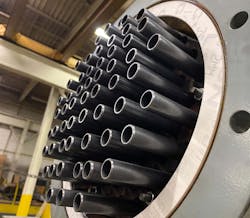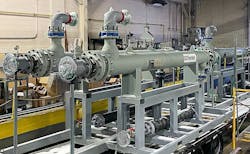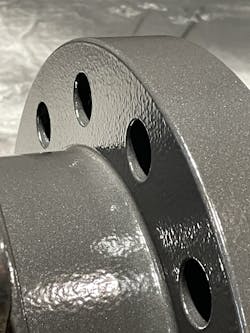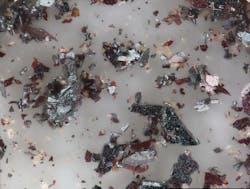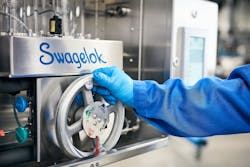The Judges
A special thank you to our judges for their time and expertise in evaluating entries for the 2023 Vaaler Awards.
- Fred Gregory, process safety and risk manager, Lubrizol, Deer Park, Texas
- Rachelle Howard, associate director of automation and controls, Vertex Pharmaceuticals, Boston
- Julie O’Brien, corporate sustainability manager, Air Products and Chemicals, Allentown, Pennsylvania
- Ellen Turner, director of strategic marketing and business development, Kentwood, Michigan
- Dave Vickery, director of product management, Aspen Technology, Midland, Michigan
For nearly 60 years, Chemical Processing has been bestowing the Vaaler Awards biennially. These awards acknowledge products with the potential to significantly improve operations at plants. The eligible entries for this year's awards were those introduced to the commercial market in the United States between May 2021 and June 2023.
The awards are named after John C. Vaaler (1899–1963), chairman of Chemical Processing’s editorial board from 1961 until his death. He became the publication’s editor-in-chief in 1946, after 24 years in the chemical and related industries.
An impartial panel judged the entries. It consisted of the members of Chemical Processing’s editorial board — a group of technical professionals with diverse responsibilities and from a variety of industry sectors (see sidebar). The panel scored all entries on three criteria: technical significance; novelty or uniqueness; and breadth of applicability. The judges weren’t required to give any awards — but did choose to honor three products:
- CG Thermal, LLC for Impervite PPS-GR
- Sherwin-Williams Protective and Marine for Heat-Flex CUI-Mitigation Coatings
- Swagelok for Swagelok Ammonia Sampler
Enhanced Graphite Heat Exchangers
CG Thermal, Twinsburg, Ohio, is the winner of a 2023 Vaaler Award in the Heating and Cooling category with its Impervite PPS-GR heat exchanger material.
PPS-GR is the result of CG Thermal’s efforts to design enhancements for graphite heat exchangers that maximize ease of maintenance while minimizing downtime and related costs. These enhancements also needed to provide the corrosion resistance of graphite with a more forgiving design for chemical industry processing environments.
A partnership with high-performance polymer extruder Technoform, based in Kassel, Germany, ultimately led to the development of the Impervite PPS-GR shell and tube heat exchanger (Figures 1 and 2).
During testing in corrosive acid streams at elevated temperatures, the graphite composite tubes show corrosion resistance similar to traditional graphite.
Meanwhile, the material characteristics and low friction surface of the PPS-GR reduce fouling potential. Another benefit is that deposits bond weakly with the tube, allowing surface cleaning with low-pressure water. This, in turn, equates to higher overall performance and lower maintenance costs.
The composite graphite tube is much more ductile than traditional impervious graphite tubes, so it’s more resistant to vibration and other mechanical stresses.
This proprietary, self-contained elastomeric sealing system makes the tubes completely field repairable without the need for specialized tools or highly specialized welding procedures, minimizing downtime and eliminating shipping concerns. It uses a specially selected combination of elastomeric seals and PTFE support rings. When coupled together with the close tolerance tube nut and tube sheet hole, it makes a highly reliable, static, self-contained seal that has an exceptional service life and is 100% leak-free.
“In a traditional impregnated graphite tube exchanger repair, you have to drill out the old tube, replace it with the new tube and cement it in place,” says Joan Bova, CG Thermal vice president of sales and engineering. “This can be accomplished in the field, but it’s both laborious and expensive. A lot of people opt to send them to our repair shop in Baton Rouge [Louisiana], and we can turn them around very quickly for customers, but to be able to do that in-house, within a shift, significantly reduces downtime and costs.
“Our proprietary system allows us to remove one individual tube in the field in a relatively easy fashion. That’s where we see the most universal benefit with the PPS-GR.”
Earlier versions of PPS-GR have been working long term and problem free in different operational environments. For example, Bova says that one has been working with a flue-gas system for more than five years and another with an aggressive chemical process for more than three years.
During a recent and bitterly cold winter, a chemical plant put the serviceability of the PPS-GR sealing system to test. The plant, which doesn’t typically suffer from freezing weather, experienced a sudden temperature drop, resulting in tubes frozen in service fluid. What would have been a time-consuming repair on a typical graphite heat exchanger was quickly remedied, avoiding a long shutdown.
“The affected tubes were replaced in very short order and have had no operational issues since,” says Bova.
Meanwhile, the company continues to work with customers and Technoform to further develop Impervite PPS-GR.
“It’s still a novel material, and we continue to learn more as it is proved out in field testing. What we have seen thus far is that it functions very much like traditional impregnated graphite tube,” Bova says.
Judge’s comment: “Graphite shell and tube heat exchangers are used in severe service applications where metallic tubes would quickly corrode. The historic issue with them is that due to their brittle nature and inability to withstand thermal shock, a crack propagates through the tube bundle, requiring complete replacement. A design that allows single tube replacement provides a tremendous economic advantage.”
Coating Combats Corrosion Under Insulation
Sherwin-Williams Protective & Marine, Cleveland, Ohio, is a winner in the Miscellaneous (Corrosion & Control Products) category with its Heat-Flex corrosion under insulation (CUI)-mitigation coatings.
Launched in June 2023, the company designed the four new coatings to mitigate CUI, a condition that can limit coating life and result in leaks, fires and even explosions in insulated assets including process piping and vessels, storage tanks, valves and fittings (Figures 3 and 4).
With some coating service life reduced to just five years — or less — by CUI, operating companies need frequent shutdowns to peel off insulation to inspect coatings, reapply them if necessary and add new insulation. This process typically only gives a short period of protection before needing to be carried out again.
“It’s gotten to the point where many large chemical and petrochemical companies have a separate budget to maintain CUI outside of their typical maintenance budget,” explains Johnny Pourciau, the company’s energy market director for the United States, Canada and Caribbean.
The next generation of Heat-Flex CUI mitigation coatings from the company staves off this corrosion process much longer, enhancing safety, reducing downtime and lowering operational costs.
The new lineup includes the Heat-Flex ACE (Advanced CUI Epoxy) coating, plus three coatings enhanced with micaceous iron oxide (MIO): Heat-Flex 650, Heat-Flex 750 and Heat-Flex 1200 Plus.
In tests, Heat-Flex ACE provided external protection to pipes, valves and vessels operating from -196ºC (-321ºF) to 232ºC (450ºF).
“Heat-Flex ACE is a great example of how our product development process is moving the goalposts,” says Neil Wilds, global product director. “To break away from the pack, we looked at CUI from a chemistry point of view rather than from a pigmentation point of view. The building blocks for ACE were the chemistries and technologies in our product portfolios and customer demands, including resistance to pH swing, resistance to acids and alkalis, resistance to chlorides and sulfates, and crack resistance.
“It was a case of looking at the barrier chemistry. We moved from using a flaky pigment barrier to a tightly cross-linked resin system.”
Meanwhile, the MIO-enhanced coatings rely on the barrier properties of MIO pigmentation, with each featuring a minimum MIO concentration of 25% by weight in the dried coating film. This additive helps extend the life of the coating and reduces risk by addressing typical CUI failure mechanisms experienced during operation, shipping and construction.
For example, Heat-Flex 650 is aimed at applications requiring high-temperature epoxy novolac resin coatings. With its higher MIO concentration than other high-temperature epoxy phenolics on the market, the coating improves crack and UV erosion resistance and lowers VOC permitting costs. The coating operates from cryogenic temperatures to 205ºC (401ºF).
Heat-Flex 750 is a two-component, high solids (78% volume) alkylated amide epoxy (AAE) which, in tests, has outperformed traditional epoxy phenolics and other AAE technologies in terms of excellent resistance to rust creep, no adhesion or blistering, plus excellent heat and crack resistance at a high dry film thickness (DFT). It is suitable for temperatures ranging from -196ºC to 205ºC (-320ºF to 401ºF).
The fourth new coating, Heat-Flex 1200 Plus, offers robust CUI-mitigation protection for aggressive and cyclic applications ranging from cryogenic to 649ºC (1,200ºF). The MIO-enhanced inert multi-polymeric matrix (IMM) coating is harder than other silicone-based coatings used in the petrochemical industry, improving protection from impacts during transit and installation, plus from chemical attacks and moisture penetration. At the same time, the material is flexible enough to withstand the thermal shock as assets expand and contract during extreme temperature fluctuations.
Customer feedback has been extremely positive. For example, two companies in Italy put Heat-Flex 750 on their spec after seeing how easy it is to apply the coating and how quickly it dries, despite its high solids content (78%).
In the United States, a major chemical company tested Heat-Flex ACE on site, eventually taking it far beyond the recommended operating temperature without the coating failing. Its robustness prompted the company and several others to put the coating on their specs, too.
Judge’s comment: “Corrosion under insulation (CUI) is a severe problem for the chemical industry with potential safety, environmental and economic effects. A more effective coating to address this often-unrecognized problem is welcome.”
Safer Ammonia Sampling
Swagelok, Solon, Ohio, won in the Instrumentation and Control category with its ammonia sampler.
Launched in June this year, the ammonia sampler makes sampling anhydrous ammonia safer, more accurate and more efficient (Figure 5).
Ammonia is widely used in chemical processing, but its water content must be kept between 0.2% and 0.5% to avoid severe stress corrosion cracking in storage tanks and damage to product quality.
However, traditional sampling processes pose inherent challenges, such as the need for operators to wear a significant amount of personal protective equipment (PPE) to avoid contact with toxic ammonia liquid and vapor when it is both being sampled and transported to a laboratory for testing.
Another is that the sampling accuracy with ammonia depends on many variables because it immediately begins to boil and evaporate as it fills warm sampling tubes.
Also, performing manual sampling effectively is challenging, often needing up to eight hours before it can be carried out.
Swagelok has reduced or eliminated these hazards by developing a semi-automated sample collection process for its ammonia sampler.
For example, its closed-loop design minimizes the chances of exposure, while its single-handled control reduces the opportunities for sampling errors. With faster results, operations can make quicker process adjustments.
Among other novel features, the Swagelok ammonia sampler uses residue tubes pre-chilled by the cold ammonia itself to avoid aggressive boiling and associated fill inaccuracies. A custom-made sampling system ensures consistent sample size.
It uses a heater to evaporate samples in a controlled manner at a constant temperature. The system then measures the remaining water after ammonia evaporation.
An intuitive touchscreen gives simple, step-by-step operating instructions.
“The initial version of the ammonia sampler was developed for one specific customer over the course of about a year in 2013,” explains Matt Dixon, application commercialization manager with Swagelok. “Over the years, word of mouth spread, which led to inquiries from other customers around the world.”
It was this widespread interest that led the company to pursue a globally commercialized product launch. First, however, Swagelok’s design engineers revisited the initial design to make the ammonia sampler more robust and to address some operational challenges of those original prototypes. That was carried out over a recent nine-month period. Among their biggest design challenges was how to control the phase change of the ammonia.
“The goal of the ammonia sampler is ultimately to evaporate the liquid ammonia sample, but we didn’t want that to happen prematurely,” Dixon says. “Therefore, we had to develop a design that effectively manages the heat transfer in and out of the sample so that the evaporation happens when we want it to, and not before.”
The design efforts are paying off. There is positive feedback from a leading ammonia producer in Europe currently using the sampler.
“The initial feedback we have received was positive with respect to ease of use for lab personnel at the customer site,” Dixon says. “This customer has continued to provide positive feedback to Swagelok, even sharing data showing the ammonia sampler’s performance compared to the customer’s legacy process. The customer has since purchased two additional units for its site.”
The Swagelok ammonia sampler is hazardous-area rated and can be customized for a variety of industrial environments, including Class 1, Div 2, Group B or ATEX Zone 2 areas.
Judge’s comment: “Ammonia is a common chemical used in refrigeration and many other applications. Sampling of the ammonia system is normally a hazardous task, potentially exposing the operator to the hazardous gas. A system to safely sample ammonia has the potential to reduce exposure and eliminate injury.”
About the Author
Seán Ottewell
Editor-at-Large
Seán Crevan Ottewell is Chemical Processing's Editor-at-Large. Seán earned his bachelor's of science degree in biochemistry at the University of Warwick and his master's in radiation biochemistry at the University of London. He served as Science Officer with the UK Department of Environment’s Chernobyl Monitoring Unit’s Food Science Radiation Unit, London. His editorial background includes assistant editor, news editor and then editor of The Chemical Engineer, the Institution of Chemical Engineers’ twice monthly technical journal. Prior to joining Chemical Processing in 2012 he was editor of European Chemical Engineer, European Process Engineer, International Power Engineer, and European Laboratory Scientist, with Setform Limited, London.
He is based in East Mayo, Republic of Ireland, where he and his wife Suzi (a maths, biology and chemistry teacher) host guests from all over the world at their holiday cottage in East Mayo.

